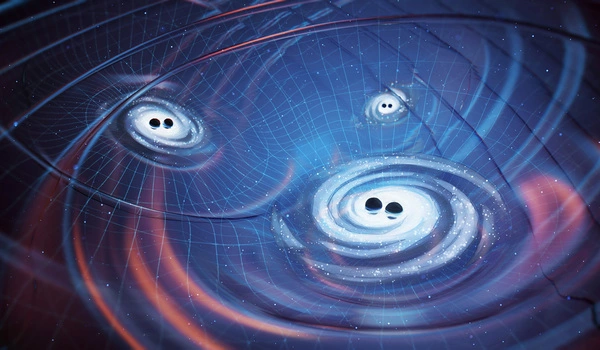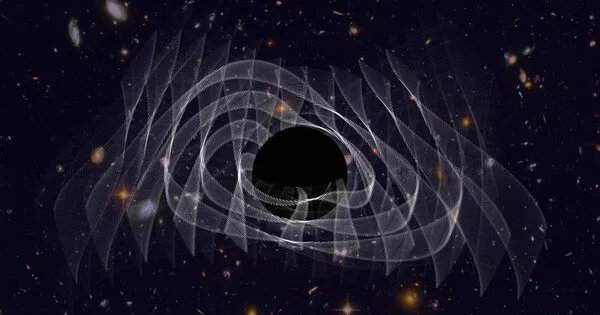Gravitational waves are disturbances in the fabric of spacetime created by enormous objects colliding, such as black holes or neutron stars. These waves were predicted by Albert Einstein’s general theory of relativity in 1915, but were not directly detected until 2015 by the Laser Interferometer Gravitational-Wave Observatory (LIGO).
You can’t see or feel it, but everything around you is gradually shrinking and increasing, even your own body. According to a new study from the NANOGrav Physics Frontiers Centre of the National Science Foundation, it’s the strange, spacetime-warping effect of gravitational waves travelling across our galaxy.
The North American Nanohertz Observatory for Gravitational Waves (NANOGrav), a joint team of researchers from more than 50 institutions in the United States and internationally, published their findings today in The Astrophysical Journal Letters. The researchers studied millisecond pulsars, which are burned-out stars that rotate hundreds of times per second and emit radio pulses like ticks from very accurate cosmic clocks.
By comparing observations of more than 60 pulsars within radio telescope data spanning 15 years, the team identified what appeared to be fluctuations in the “ticking rate” of such pulsars. Their study shows that the fluctuations are the result of low-frequency gravitational waves disrupting the fabric of physical reality known as spacetime.
The NSF NANOGrav team created, in essence, a galaxy-wide detector revealing the gravitational waves that permeate our universe. The collaboration of research institutions from across the United States demonstrates that world-class scientific innovation can, should, and does reach every part of our country.
Sethuraman Panchanathan
According to the NANOGrav team’s results, gravitational wave spatial distortion causes the radio-signal ticking rates of pulsars to appear to change. The stretching and squeezing of space between Earth and the pulsars, however, causes their radio pulses to arrive billionths of seconds earlier or later than planned. The findings provide the first proof of the gravitational wave background, a sort of soup of spacetime aberrations that scientists have long anticipated exists.
“The NSF NANOGrav team created, in essence, a galaxy-wide detector revealing the gravitational waves that permeate our universe,” NSF Director Sethuraman Panchanathan remarked. “The collaboration of research institutions from across the United States demonstrates that world-class scientific innovation can, should, and does reach every part of our country.”
Albert Einstein predicted gravitational waves for the first time in 1916. They were confirmed in 2015, when the Laser Interferometer Gravitational-Wave Observatory (LIGO) discovered spacetime ripples travelling across the Earth. Although the gravitational ripples were caused by the merger of two distant black holes, the consequent spatial distortion recorded by LIGO was smaller than the nucleus of an atom.

In comparison, the NANOGrav team recorded an apparent pulsar time shift of a few hundred billionths of a second, representing a bending of spacetime between Earth and the pulsars approximately the length of a football pitch. Gravitational waves are so massive that the distance between two crests is 2-10 light-years or around 9-90 trillion kilometres, generated the spacetime distortions.
“These are by far the most powerful gravitational waves known to exist,” said Maura McLaughlin, co-director of the NANOgrav Physics Frontiers Centre at West Virginia University. “Detecting such massive gravitational waves necessitates a similarly massive detector, as well as patience.”
Using 15 years of astronomical data recorded by radio telescopes at NSF-supported observatories – including Green Bank Observatory in West Virginia, the Very Large Array in Socorro, New Mexico, and Arecibo Observatory in Puerto Rico – the NANOGrav team created a “detector” of 67 pulsars distributed all across the sky and compared the ticking rate of pairs of those pulsars. Through a sophisticated data analysis, they deduced the presence of the gravitational wave background causing the distortion of space, and thus explained the apparent timing changes of the pulsars.
“This is the first evidence for gravitational waves at these low frequencies,” said Stephen Taylor, chair of the NANOGrav collaboration and co-leader of the research effort at Vanderbilt University. “Distant pairs of close-orbiting, ultra-massive black holes are the most likely source of these waves.”
“There is so much we don’t know about the physical nature of the universe,” said NSF Assistant Director for Mathematical and Physical Sciences Sean L. Jones. “That’s why the National Science Foundation supports daring team efforts like NANOGrav – to expand our knowledge for the benefit of society.”
The team’s findings shed new light on how galaxies form and supermassive black holes grow and fuse. The extensive spacetime distortion exhibited by their observations suggests that extremely big pairings of black holes may be equally ubiquitous throughout the universe, maybe numbering in the hundreds of thousands or even millions. The NANOGrav team hopes to be able to identify individual supermassive black hole pairings by following the gravitational waves they generate in the future. They may potentially find evidence of gravitational waves from the very beginning of the universe.





